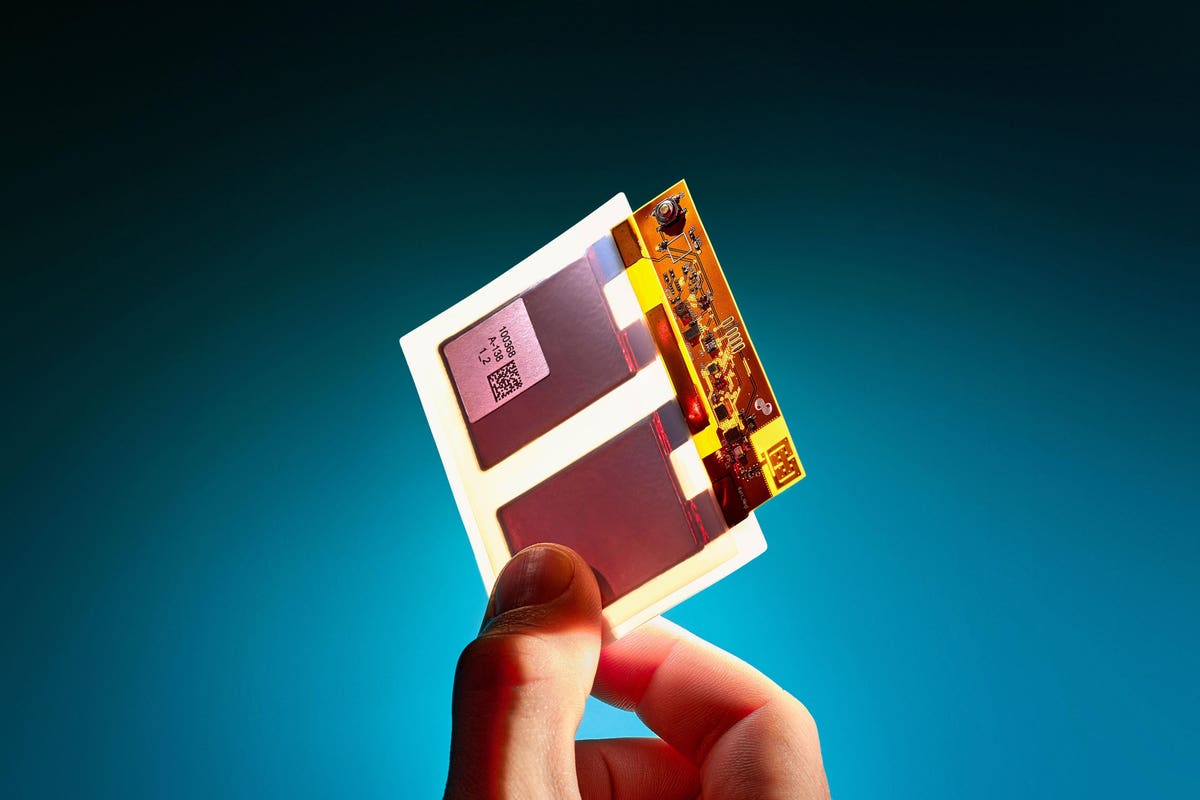Exclusive: Connectivity startup Nodle have launched the N1 Nanocomputer, an ultra-low-cost device to enable Internet of Things (IoT) devices. With an estimated production cost of less than $3 when made in bulk, the N1 is a disposable, printed design which can be produced and distributed in vast quantities. Nanocomputers can be embedded in everything, opening up new possibilities for a new connected world and ubiquitous sensors.
Printed electronics are familiar from the RFID tags stuck to consumer goods, but these are passive devices with no computing power. The N1 takes things further by adding processing, Bluetooth connectivity and sensors. The entire device including batteries and connections is printed on to backing, with only an ARM Cortex-M0 processor being added in conventional fashion.
“The key here is that we can reduce a small computer from dozens of components to theoretically two or three,” says Nodle co-founder Garrett Kinsman. “Printing a computer is far more cost effective than classical pick and place technologies.”
Two key features will allow the N1 to become ubiquitous: it is eco-friendly and open source.
Eco-friendliness is essential because the IoT requires essentially disposable devices. Conventional batteries are a disposal nightmare because of the toxic and occasionally incendiary chemicals they contain. The N1 is powered by a proprietary zinc battery chemistry called ZinCore claimed to be “not ignitable, corrosive, reactive, or toxic.” The battery on the N1 has an estimated lifetime of about five weeks, but it is also rechargeable. Kinsman says that if required, a solar cell can be added to give effectively unlimited lifetime.
Being open source is equally important, as this fosters an entire ecosystem of developers who can share code and innovate using the hardware. The success of the Raspberry Pi and the movement it gave rise to showed what minimal, low-cost computing could do with an enthusiastic user base. An IoT Nanocomputer will need the same diverse support to drive it forwards.
“We were heavily inspired by Pi, and wondered what the next iteration may look like,” says Kinsman. “Our value is in the network and ecosystem, and not in the hardware, thus open sourcing creates more compelling use cases for our blockchain.”
Because Nodle is all about the ecosystem, they want to encourage as many users as possible, hence the open-source approach. But while Raspberry Pis are mainly used individually, the N1 is very much a connected device communicating over a Bluetooth Low Energy connection.
Current IoT devices tend to be big and expensive like smart speakers and fitness trackers, or small and cheap like passive like RFID tags with minimal capability. (When pinged by a radio-frequency reader, the RFID responds with an identifying code, acting as tacking tags for clothes in a shop, pallets in warehouse or items in a factory.) Nanocomputers bridge the gap, enabling devices cheap enough to be disposable while also having significant sensing and processing power.
The N1 comes with basic sensors for temperature, humidity, shock and vibration and light levels, and can easily have more added, such as accelerometers to detect movement. Downloading an app on to any phone makes it a node in the Nodle network, connecting to and communicating with any Nodle device within range via Bluetooth. Nodes are already widespread and the makers see early uses in asset tracking.
“The biggest application is for logistics, tracking things like shipping pallets, boxes and crates,” says Kinsman.
Nodle uses a Blockchain set-up to provide what Kinsman terms a ‘zero-trust’ system , in which the root of trust is in each individual device. Hackers cannot access an individual device by breaking into the system
“Many of our customers going forward are interested in using the Nodle chain for securing data streams for audit in the future, for example secure images, energy production data,” says Kinsman.
The N1 looks ideal for anyone who wants a low-cost, distributed sensor network, one which can be safely scattered over the countryside. This is exactly the sort of design that the U.S. military have been looking at for some time.
Unattended ground sensors or UGS typically have seismic, magnetic and acoustic sensors to track vehicle movements. Some are disguised as rocks. An early version were dropped from the air in Vietnam under the Igloo White program to track movement along the Ho Chi Minh trail. Each device was the size of a fencepost and cost thousands of dollars, communicating via a specially-equipped aircraft circling overhead. Modern versions have satellite communications.
The U.S. Army plans to scatter thousands of such sensors behind enemy lines via drone of even from stratospheric balloons. These would build up a complete picture of vehicle movements and radio emissions over a wide area, with enough processing power to identify and pinpoint every vehicle and radio type. This would enable long-range precision strikes by weapons like HIMARS and ATACMS.
This type of military IoT requires sensors small and cheap enough to be deployed in vast numbers, and Nodle’s new device shows that this is possible.
“Zero-trust systems will be essential for securing these types of sensors,” adds Kinsman. “This is already becoming the standard in DoD.”
In the 20th century, the military tended to get the best technology first. But the rapid advance of commercial electronics has changed that. In the early 2000s, the Army’s Land Warrior tactical computer system was switched from custom-built military electronics to commercial tablet devices which were lighter, faster and much cheaper. As we advance into the Internet of Things era, the military may again be looking at what it can pick up from the consumer sector.
“The Nanocomputer is a first step towards Smart Dust,” says Kinsman, who foresees even smaller devices costing less than a dollar in the near future.
The concept of Smart Dust has been around for decades, tiny wireless devices perhaps no bigger than a grain of sand, scattered everywhere to sense temperature, vibration and other factors. Such devices would have a myriad of applications in industry, agriculture, health and security, but have always looked well out of reach. Now Smart Dust is visible on the horizon, and the N1 is a milestone on the way.
And for anyone interested in using the N1, the open source code is available now.
Read the full article here





